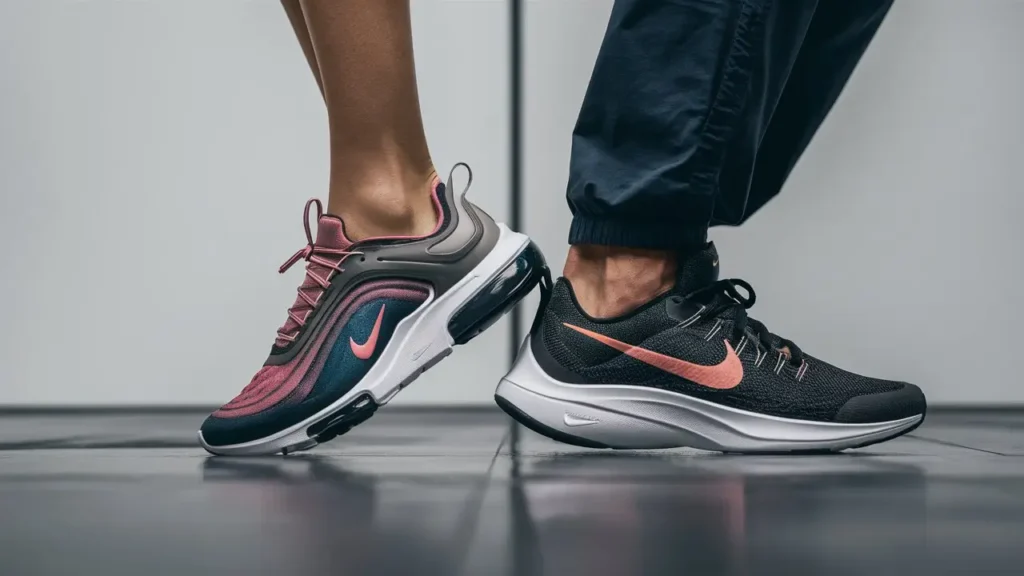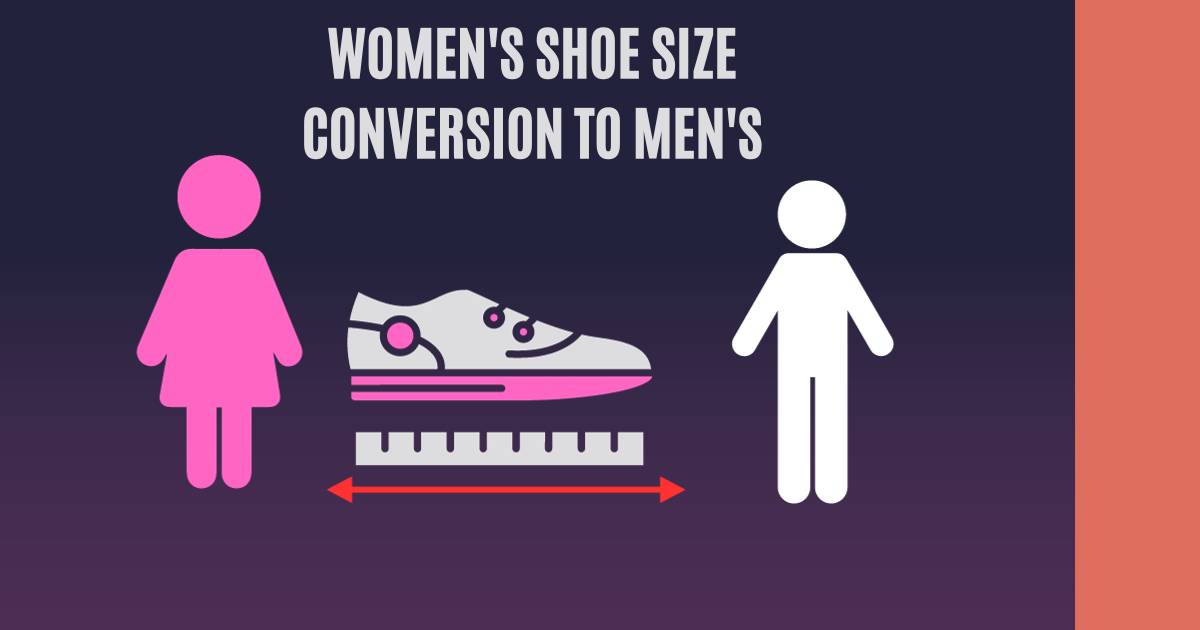To convert women’s shoe sizes to men’s, subtract 1.5 sizes from the women’s size. This chart simplifies finding the equivalent men’s shoe size.
Shopping for shoes can be challenging, especially when dealing with unisex styles or brands that offer only men’s or women’s sizing. Understanding the size conversion is crucial for a comfortable fit and can save time and hassle. Our Women’s to Men’s Shoe Size chart provides a quick and accurate way to determine the correct size you need when switching between gender-specific shoes.
With just a simple input of your known size, the Chart adjusts the scale, ensuring you make informed choices whether you’re browsing online or in-store. Say goodbye to the confusion of size charts and embrace the ease of shopping with confidence for the perfect pair of shoes.
Understanding Shoe Sizing
Shoes are more than fashion statements; they’re a blend of function and comfort. But finding the perfect fit can be tricky, especially when converting between women’s and men’s sizes. A Women’s to Men’s Shoe Size Chart simplifies this conversion, helping shoppers find the right size across genders. Let’s dive into the world of shoe sizing and understand how sizes vary.
Differences In Women’s And Men’s Shoe Sizing
Shoe sizes are not universal. A woman’s size 8 is not the same as a man’s size 8. Typically, men’s shoes are about 1.5 to 2 sizes larger than women’s. This difference stems from variations in foot shape and width. Men’s feet are often wider and longer than women’s. To ensure a good fit, it’s crucial to understand these differences. For instance:
- Length: Men’s shoes are generally longer in the same size.
- Width: Men’s shoes are built for wider feet.
- Design: The style and cut can affect the overall fit.
Let’s look at a comparison table to illustrate the size conversion:
| Women’s US Size | Men’s US Size (approx.) |
|---|---|
| 5 | 3.5 |
| 6 | 4.5 |
| 7 | 5.5 |
Using a Women’s to Men’s Shoe Size chart is simple. Enter your women’s shoe size, and it outputs the corresponding men’s size. This tool takes the guesswork out of shopping for unisex or men’s footwear.
International Shoe Sizing Standards
Shoe sizes can be confusing, especially when purchasing from international brands. Different countries follow different sizing standards. The US, UK, EU, and Japan all have unique size charts. A size 8 in the US is not the same in the UK or Europe. The key to a comfortable fit lies in understanding these global standards.
- The US and Canada typically use the same sizing system.
- The UK sizing is about 2 sizes smaller for men and 2.5 sizes for women compared to US sizes.
- European sizes are unisex and are based on the length of the foot in centimeters.
- Japan also uses centimeters, but the sizes are not directly comparable to European sizes.
To help visualize, here’s a basic conversion chart:
| US Size | UK Size | EU Size | JP Size (cm) |
|---|---|---|---|
| 7 | 6 | 40 | 25 |
| 8 | 7 | 41 | 26 |
| 9 | 8 | 42 | 27 |
Remember, the best way to find your international shoe size is to measure your foot length in centimeters and use a reliable size conversion chart. Always double-check with the specific brand’s size guide for the best fit.
Calculating Women’s To Men’s Shoe Size
Do you ever find the perfect pair of shoes, but they’re not in your gender’s sizing? No worries! With a Women’s to Men’s Shoe Size chart, you can easily find your match. Converting women’s shoe sizes to men’s sizes is simple. This guide will help you understand how to make the switch so you can walk away with shoes that fit you perfectly.
Using Conversion Charts
Finding your shoe size in the men’s department is easy with a conversion chart. These charts show the equivalent sizes across different genders. Here’s how to use them:
- Start with your women’s shoe size.
- Look at the chart and find your size on the women’s side.
- Directly across the chart, you’ll see your men’s shoe size.
A typical conversion chart might look like this:
| Women’s US Size | Men’s US Size |
|---|---|
| 5 | 3.5 |
| 6 | 4.5 |
| 7 | 5.5 |
| 8 | 6.5 |
| 9 | 7.5 |
| 10 | 8.5 |
| 11 | 9.5 |
| 12 | 10.5 |
Remember, the difference between women’s and men’s sizes usually is about 1.5 to 2 sizes. Always check the chart before buying to ensure a good fit.
Adjusting For Width And Style Differences
When switching from women’s to men’s shoes, consider width and style. Men’s shoes are often wider and have a different cut. Here’s what to remember:
- Width: Men’s shoes are typically D width, while women’s are B.
- Fit: Try on the shoes to ensure they’re not too loose or tight.
- Style: Men’s and women’s shoes may look different, even in the same size.
For a better fit, some brands offer unisex models or wide and narrow options. This table shows how widths vary:
| Width | Women’s | Men’s |
| Narrow | B | B |
| Medium | D | D |
| Wide | E | E |
When in doubt, ask a store assistant for help. They can guide you to find a shoe that fits your foot shape and size. Always try on shoes before buying to ensure comfort and style meet your needs.
Brand Shoe Size Charts
Women to Men Nike Shoe Size Conversion Charts

Here is a table converting Nike women’s shoe sizes to men’s shoe sizes along with UK, EU sizes, and foot lengths in inches:
| US – Women’s | US – Men’s | UK | EU | Foot Length (in) |
|---|---|---|---|---|
| 3.5 | 2 | 1.5 | 33.5 | 8 3/16 |
| 4 | 2.5 | 1.5 | 34.5 | 8 5/16 |
| 4.5 | 3 | 2 | 35 | 8 1/2 |
| 5 | 3.5 | 2.5 | 35.5 | 8 11/16 |
| 5.5 | 4 | 3 | 36 | 8 13/16 |
| 6 | 4.5 | 3.5 | 36.5 | 9 |
| 6.5 | 5 | 4 | 37.5 | 9 3/16 |
| 7 | 5.5 | 4.5 | 38 | 9 5/16 |
| 7.5 | 6 | 5 | 38.5 | 9 1/2 |
| 8 | 6.5 | 5.5 | 39 | 9 11/16 |
| 8.5 | 7 | 6 | 40 | 9 13/16 |
| 9 | 7.5 | 6.5 | 40.5 | 10 |
| 9.5 | 8 | 7 | 41 | 10 3/16 |
| 10 | 8.5 | 7.5 | 42 | 10 5/16 |
| 10.5 | 9 | 8 | 42.5 | 10 1/2 |
| 11 | 9.5 | 8.5 | 43 | 10 11/16 |
| 11.5 | 10 | 9 | 44 | 10 13/16 |
| 12 | 10.5 | 9.5 | 44.5 | 11 |
| 12.5 | 11 | 10 | 45 | 11 3/16 |
| 13 | 11.5 | 10.5 | 45.5 | 11 5/16 |
| 13.5 | 12 | 11 | 46 | 11 1/2 |
| 14 | 12.5 | 11.5 | 47 | 11 11/16 |
| 14.5 | 13 | 12 | 47.5 | 11 13/16 |
| 15 | 13.5 | 12.5 | 48 | 12 |
| 15.5 | 14 | 13 | 48.5 | 12 3/16 |
| 16 | 14.5 | 13.5 | 49 | 12 5/16 |
| 16.5 | 15 | 14 | 50 | 12 1/2 |
| 17 | 15.5 | 14.5 | 50.5 | 12 11/16 |
| 17.5 | 16 | 15 | 51 | 12 13/16 |
| 18 | 16.5 | 15.5 | 51.5 | 13 |
| 18.5 | 17 | 16 | 52 | 13 3/16 |
| 19 | 17.5 | 16.5 | 52.5 | 13 5/16 |
| 19.5 | 18 | 17 | 53 | 13 1/2 |
| 20 | 18.5 | 17.5 | 53.5 | 13 11/16 |
| 20.5 | 19 | 18 | 54 | 13 13/16 |
| 21 | 19.5 | 18.5 | 54.5 | 14 |
| 21.5 | 20 | 19 | 55 | 14 3/16 |
| 22 | 20.5 | 19.5 | 55.5 | 14 5/16 |
| 22.5 | 21 | 20 | 56 | 14 1/2 |
Women to Men Bata Shoe Size chart
| US – Women’s | US – Men’s | Bata Size | Inches | CM | Europe | UK Size |
|---|---|---|---|---|---|---|
| 6.5 | 5 | 5 | 10 | 24.5 | 38 | 5 |
| 7.5 | 6 | 6 | 10 1/4 | 25.1 | 39/40 | 6 |
| 8.5 | 7 | 7 | 10 1/8 | 25.7 | 41 | 7 |
| 9.5 | 8 | 8 | 11 | 26.3 | 42 | 8 |
| 10.5 | 9 | 9 | 11 1/4 | 26.9 | 43 | 9 |
| 11.5 | 10 | 10 | 11 5/8 | 27.5 | 44 | 10 |
| 12.5 | 11 | 11 | 12 | 28.1 | 45 | 11 |
Women to Men ADIDAS Footwear Sizing

| Heel-toe (INCH) | Heel-toe (CM) | US – Men | US – Women | EU | UK | JP |
|---|---|---|---|---|---|---|
| 8.7″ | 22.1 cm | 4 | 5 | 36 | 3.5 | 220 |
| 8.9″ | 22.5 cm | 4.5 | 5.5 | 36 2/3 | 4 | 225 |
| 9.0″ | 22.9 cm | 5 | 6 | 37 1/3 | 4.5 | 230 |
| 9.2″ | 23.3 cm | 5.5 | 6.5 | 38 | 5 | 235 |
| 9.4″ | 23.8 cm | 6 | 7 | 38 2/3 | 5.5 | 240 |
| 9.5″ | 24.2 cm | 6.5 | 7.5 | 39 1/3 | 6 | 245 |
| 9.7″ | 24.6 cm | 7 | 8 | 40 | 6.5 | 250 |
| 9.8″ | 25.0 cm | 7.5 | 8.5 | 40 2/3 | 7 | 255 |
| 10.0″ | 25.5 cm | 8 | 9 | 41 1/3 | 7.5 | 260 |
| 10.2″ | 25.9 cm | 8.5 | 9.5 | 42 | 8 | 265 |
| 10.4″ | 26.3 cm | 9 | 10 | 42 2/3 | 8.5 | 270 |
| 10.5″ | 26.7 cm | 9.5 | 10.5 | 43 1/3 | 9 | 275 |
| 10.7″ | 27.1 cm | 10 | 11 | 44 | 9.5 | 280 |
| 10.9″ | 27.6 cm | 10.5 | 11.5 | 44 2/3 | 10 | 285 |
| 11.0″ | 28.0 cm | 11 | 12 | 45 1/3 | 10.5 | 290 |
| 11.2″ | 28.4 cm | 11.5 | 12.5 | 46 | 11 | 295 |
| 11.3″ | 28.8 cm | 12 | 13 | 46 2/3 | 11.5 | 300 |
| 11.5″ | 29.3 cm | 12.5 | 13.5 | 47 1/3 | 12 | 305 |
| 11.7″ | 29.7 cm | 13 | 14 | 48 | 12.5 | 310 |
| 11.9″ | 30.1 cm | 13.5 | 14.5 | 48 2/3 | 13 | 315 |
| 12.0″ | 30.5 cm | 14 | 15 | 49 1/3 | 13.5 | 320 |
| 12.2″ | 31.0 cm | 14.5 | 15.5 | 50 | 14 | 325 |
| 12.4″ | 31.4 cm | 15 | – | 50 2/3 | 14.5 | – |
| 12.7″ | 31.8 cm | 16 | – | 51 1/3 | 15 | – |
| 13.0″ | 32.6 cm | 17 | – | 52 2/3 | 16 | – |
| 13.3″ | 33.5 cm | 18 | – | 53 1/3 | 17 | – |
| 13.7″ | 34.3 cm | 19 | – | 54 2/3 | 18 | – |
| 14.0″ | 35.2 cm | 20 | – | 55 2/3 | 19 | – |
Womwn to Men New Balance Shoe Size conversion chart
Here is a complete table for women’s to men’s New Balance shoe size conversion, including UK sizes, EU sizes, and length in centimeters:
| US Women | US Men | UK | EU | Length (cm) |
|---|---|---|---|---|
| 4 | 2.5 | 2 | 34 | 21 |
| 4.5 | 3 | 2.5 | 34.5 | 21.5 |
| 5 | 3.5 | 3 | 35 | 22 |
| 5.5 | 4 | 3.5 | 36 | 22.5 |
| 6 | 4.5 | 4 | 36.5 | 23 |
| 6.5 | 5 | 4.5 | 37 | 23.5 |
| 7 | 5.5 | 5 | 37.5 | 24 |
| 7.5 | 6 | 5.5 | 38 | 24.5 |
| 8 | 6.5 | 6 | 39 | 25 |
| 8.5 | 7 | 6.5 | 40 | 25.5 |
| 9 | 7.5 | 7 | 40.5 | 26 |
| 9.5 | 8 | 7.5 | 41 | 26.5 |
| 10 | 8.5 | 8 | 41.5 | 27 |
| 10.5 | 9 | 8.5 | 42.5 | 27.5 |
| 11 | 9.5 | 9 | 43 | 28 |
| 11.5 | 10 | 9.5 | 43.5 | 28.5 |
| 12 | 10.5 | 10 | 44 | 29 |
| 12.5 | 11 | 10.5 | 45 | 29.5 |
| 13 | 11.5 | 11 | 45.5 | 30 |
| 13.5 | 12 | 11.5 | 46 | 30.5 |
| 14 | 12.5 | 12 | 46.5 | 31 |
| 15 | 13 | 13 | 48 | 32 |
This table should help you easily convert between women’s and men’s New Balance shoe sizes, including additional size references for UK, EU, and length in centimeters.
Tips For Accurate Sizing
Finding the perfect shoe fit can be a challenge, especially when converting from women’s to men’s sizes. A shoe size chart simplifies this process, but accurate sizing requires more than just numbers. Here are essential tips to ensure the best fit.
Consideration Of Foot Shape
Every foot is unique, making shape a critical factor in shoe sizing. Here’s what you need to consider:
- Length and width: Measure both to get a complete picture.
- Arch type: High, medium, or low, each affects fit differently.
- Toe box: Ensure ample space for comfort and movement.
Remember, the right fit goes beyond length. Your foot’s shape can lead to size adjustments. Use this table as a starting point:
| Foot Shape | Size Adjustment |
| Narrow | Consider a smaller width |
| Wide | Opt for a wider fit |
| High Arch | Look for added support |
Test the fit with your usual socks and walk around to ensure comfort and no slipping.
Accounting For Half Sizes And Widths
Half sizes and width variations are vital for a precise fit. Keep these points in mind:
- Half Sizes: Offer a closer fit than full sizes.
- Widths: Brands offer a range, from narrow (N) to extra-wide (EW).
Consider this example to illustrate the importance of half sizes and widths:
| Women’s Size | Men’s Equivalent |
|---|---|
| 7.5 Regular (R) | 5.5 Regular (R) |
| 7.5 Wide (W) | 5.5 Wide (W) |
Always try on shoes later in the day when feet are their largest. Remember, snug but not tight ensures the best fit. Your toes should have wiggle room.
Choosing The Right Fit
Finding shoes that fit well is essential, and using a Women’s to Men’s Shoe Size chart can make the process easier. A perfect fit means more than just getting the size right. It’s about ensuring that every step is comfortable and your feet have the necessary support. Let’s dive into why selecting the right fit is crucial for your feet’s health and your overall comfort.
Impact Of Comfort And Support
Finding a shoe that feels like it’s made just for you is a game-changer. It’s not only about how it looks, but also how it feels and supports your foot. Here’s why comfort and support matter:
- Prevents Blisters: Shoes that fit poorly can cause friction and lead to painful blisters.
- Reduces Foot Pain: A supportive shoe can help alleviate pain in the feet, ankles, and even the back.
- Improves Posture: Properly fitting footwear promotes good posture by providing adequate support.
- Enhances Performance: For athletes, the right shoe can improve performance and prevent injuries.
Consider the following when looking for comfort and support:
| Feature | Benefit |
|---|---|
| Cushioning | Provides shock absorption and comfort. |
| Arch Support | Helps distribute pressure and supports the foot’s natural shape. |
| Breathability | Keeps feet dry and cool, reducing the risk of fungal infections. |
| Roomy Toe Box | Gives toes space to move, reducing the risk of bunions and hammertoes. |
Understanding The Importance Of Trying Shoes On
Even with a shoe size calculator, nothing beats trying shoes on for the perfect fit. Here’s why:
- Feel the Fit: You can immediately sense if the shoe is tight, loose, or just right.
- Check the Width: Your foot width is as important as length. Trying on ensures width comfort.
- Test the Flexibility: You can bend the shoe to see if it matches your foot’s flexing point.
- Walk Around: Walking in the shoe tells you if it slips or if there’s adequate cushioning.
Remember these points when trying on shoes:
- Try shoes in the afternoon when your feet are at their largest.
- Wear the type of socks you’ll wear with the shoes.
- Stand in the shoes to check for about a thumb’s width of space in front of the toes.
- Walk on different surfaces if possible to test the shoe’s grip and comfort.
Common Mistakes To Avoid
Finding the right shoe size is crucial for comfort and foot health. A Women’s to Men’s Shoe Size Calculator can help make this process easier. But, it’s important to dodge some common sizing traps. Let’s explore these and learn how to get the best fit.
Relying Solely On Numeric Size Conversion
It’s tempting to think that shoe sizing is as simple as plugging in numbers. But this can lead to mistakes. Here’s why:
- Numeric conversion doesn’t account for width differences between men’s and women’s shoes.
- Sizes vary internationally, meaning a US size might not match a UK size.
- Foot shape is unique and goes beyond just length and width.
Let’s break down these points with examples:
| Women’s Size (US) | Men’s Size (US) | Width Consideration |
|---|---|---|
| 8 | 6.5 | Women’s M might be narrower than Men’s M |
| 9 | 7.5 | Width can differ brand to brand |
Avoid a poor fit by:
- Measuring your feet in the afternoon when they are at their largest.
- Checking size charts for each brand, as they can differ.
- Considering shoe reviews for fit advice from other buyers.
Special Considerations
Figuring out the right shoe size can be tricky, especially when converting women’s to men’s sizes. But, it’s not just about numbers. There are special considerations to keep in mind. They ensure a perfect fit every time. Let’s delve into the details and make shoe shopping a breeze!
Sizing For Athletic And Performance Shoes
When it comes to athletic and performance shoes, the fit is critical. A perfect match boosts comfort and performance. Here are some key points to remember:
- Brand-specific sizing: Brands may have unique sizing charts. Always check the brand’s official guide before buying.
- Activity type matters: Different sports need different fits. For example, runners might want a snugger fit to prevent slipping.
- Width options: Athletic shoes often come in various widths. Make sure to consider both length and width for a true fit.
Here’s a quick reference table to help with the basics of athletic shoe size conversion:
Add more rows as needed
| Women’s US Size | Men’s US Size |
|---|---|
| 7 | 5.5 |
| 8 | 6.5 |
| 9 | 7.5 |
Remember, for a personal fit, try them on. A size calculator is a start, but your feet decide the final say.
Adapting For Unisex Or Non-binary Sizing
Unisex or non-binary sizing takes a one-size-fits-all approach, but feet are unique. Here’s how to navigate this space:
- Start with a standard: Unisex models often use men’s sizing as a base. Women should go down 1.5 to 2 sizes for a good fit.
- Look for size tips: Product descriptions might give clues. They can suggest if you should size up or down.
- Consider the design: Some unisex shoes are wider. Pay attention to how the shoe’s shape might affect your fit.
Below is a simple chart to guide you through unisex shoe sizing:
Add more rows as needed
| Unisex Size | Women’s Equivalent | Men’s Equivalent |
|---|---|---|
| 6 | 7.5-8 | 6 |
| 7 | 8.5-9 | 7 |
| 8 | 9.5-10 | 8 |
Final tip: Reviews can be gold. See what others say about the fit. It can save you time and ensure your next pair feels just right.
Frequently Asked Questions
How To Convert Women’s Shoe Size To Men’s?
To convert women’s shoe sizes to men’s, subtract 1. 5 from the women’s size. For example, a woman’s size 8. 5 would be a man’s size 7. Always check brand-specific size charts for accuracy.
What Is Size 8 In Women’s To Men’s?
A women’s size 8 shoe converts to a men’s size 6. 5. This sizing difference is typically a 1. 5-point variation between genders.
What Is A Men’s Shoe Size 13 In Women’s Shoes?
A men’s shoe size 13 typically translates to a women’s shoe size 14. 5. Always check the brand’s size chart for the most accurate conversion.
Conclusion
Navigating the differences in shoe sizing doesn’t have to be a hurdle. Our Women’s to Men’s Shoe Size Calculator simplifies the process, ensuring a perfect fit every time. Embrace the ease of online shopping with this handy tool at your fingertips, and step out with confidence, knowing you’ve made the right choice for your feet.


